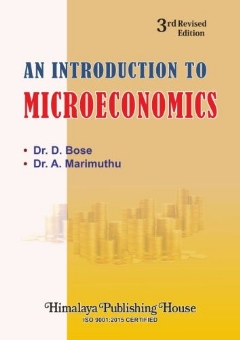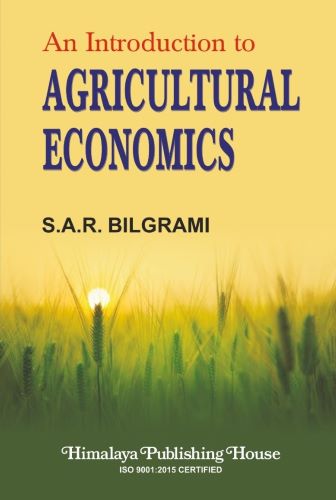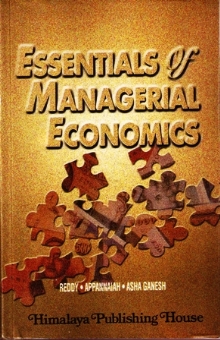The book “MATHEMATICAL ECONOMICS” is mainly written based on the requirements of the average students. Another feature of this book is precise and concise exposition of the methods and techniques of Mathematics along with their applications in Economics to the beginners. This book covers the syllabi of various autonomous colleges and leading Universities in India. This book also covers the new syllabus of the course Mathematical Economics prescribed by the Tamil Nadu State Council for Higher Education (TANSCHE). The exhaustive solved problems and problems for practice with answers at the end of each chapter will make the students familiar with the mathematical tools and their applications in economics. Exercises in the form of multiple choices questions with answers including UGC-NET questions have been given at the end of the respective chapters to enable the students preparing for the UGC Test for Junior Research Fellowship (JRF) and National Eligibility Test (NET) / State Level Eligibility Test (SET) for Lectureship.
Contents –
1. INTRODUCTION
Nature and Scope of Mathematical Economics – Role of Mathematics in Economic Theory – Mathematical Economics vs Literary Economics – Mathematical Economics vs Econometrics.
2. ELEMENTARY ALGEBRA
Exponents or Theory of Indices – The Real Number System – Properties of Real Numbers (or) Axioms of Real Numbers – Constant – Variable – L.C.M. and H.C.F. (G.C.D.) – Simple Operations – Decimals – Removal of Brackets – Rational Expressions – Functions and their Graphical Representation – Forms or Types or Classifications of Functions – Analytical Geometry of Two Dimensions – Different Forms of Equations of a Straight Line – Equations – Limit and Continuity – Limit – Continuity of a Function.
3. DIFFERENTIAL CALCULUS
Calculus – Rules of Differentiation – Partial Differentiation – Total Differentiation – Maxima and Minima – Maxima and Minima of Two or More Variables.
4. THEORY OF CONSUMER BEHAVIOUR
(A) Cardinal Utility Approach or Marshall’s Approach – Total Utility and Marginal Utility – Nature of The Commodity (B) Ordinal Utility Approach or Hicksian Approach or Indifference Curve Approach – Mathematical Derivation of Consumer’s Equilibrium or Maximisation of Utility or Maximisation of Satisfaction – Maximisation of Utility – (b) Constrained Utility Maximisation (or) Lagrange’s Method of Consumer’s Equilibrium – Slutsky Equation or Slutsky Theorem or Slutsky Decomposition – Slutsky Equation in Elasticity Form.
5. THEORY OF FIRM’S BEHAVIOUR
Production Function – Maximisation of Profit or Equilibrium of The Firms or Producer’s Equilibrium – Constrained Profit (Output) Maximisation or Lagrange’s Method of Maximisation of Profit – Constrained Profit (Output) Maximisation or Lagrange’s Method of Maximisation of Profit – Market Equilibrium – Equilibrium of The Two Separate Markets or Joint Production by Monopolists – Homogeneous Function – Cobb-Douglas Production Function – Euler’s Theorem – C.E.S. Production Function.
6. THEORY OF COST AND REVENUE
Cost Functions and Curves — Revenue Functions and Curves. – Cost Functions and Curves – Cost Curves – Revenue Functions and Curves – Revenue Curves.
7. INTEGRAL CALCULUS
Meaning – Some Basic Rules of Integration – Definite Integration or Definite Integral – Area Between Two Curves – Cost Functions – Revenue Functions – Capital Formation – Interest Rate – Consumer’s Surplus – Producers Surplus.
8. SET THEORY
Meaning – Definition – Forms of Sets – Set Operations or Algebra of Sets Venn Diagrams – Ordered Pairs – Cartesian Product.
9. MATRICES
Meaning – Algebra of Matrices (or) Operations with Matrices – Laws (or) Properties of Matrix Addition – Properties of Matrix Multiplication – Transpose of a Matrix – Determinants – Rank of a Matrix – Minor Cofactor – Adjoint of a Matrix (or) Adjugate of a Matrix – Solving A System of Linear of Equations – Testing Consistency Linear Equations – Input-output Analysis – Basic Concepts – The Hawkins – Simon Conditions.
10. DIFFERENTIAL AND DIFFERENCE EQUATIONS
Differential Equation – Solutions of Differential Equations – Difference Equations – Solutions of Difference Equations.
11. ECONOMIC MODELS
Meaning of Model – Definition of Model – Meaning of Economic Model – Meaning of Econometric Model – Economic Model vs Econometric Model – National Income Analysis – Measurement of National Income or Methods of Calculating National Income or Methods of Estimation of National Income – Circular Flow of National Income – National Income Model – Solving National Income Model Using Cramer’s Rule – Solving National Income Model Using Inverse Method or Matrix Method – Multiplier and Accelerator Interaction or Leverage Effect or Super Multiplier – Super Multiplier – Domar Economic Growth Model – Mathematical Form of Domar Model – The Cobweb Model.
12. LINEAR PROGRAMMING
Introduction – Meaning – Basic Concepts – Mathematical Formulation of LPP – Mathematical Formulation – The Graphical Method – The Simplex Method.
13. GAME THEORY
Introduction – Game Theory and Economics – Game – Properties of a Game – Types of Game – Constructing (or) Building a Pay-Off Matrix – Various Concepts – Conversion of a Game Problem into LPP – Procedure To Solve LPP by Simplex Method – Ways of Solving a Two – Person Zero Sum Game – Principle of Dominance.
APPENDIX
Algebraic Symbolism – Logarithms – Equations of Circles – Permutations and Combinations – Fundamental Principle – Permutations – Circular Permutations – Combinations – Binomial Theorem for any Index – Trigonometric Ratios – Values of Trigonometric Functions – Suggested Readings – Tables







